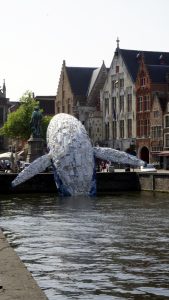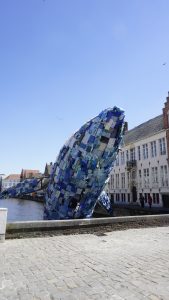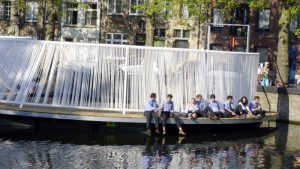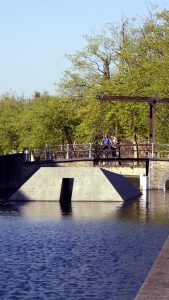
Photograph copyright Shaun Villiers Everett 2018
As part of a planned trip to ‘Flander’s Fields’, I took some time out to look in on the opening week of the latest Bruges’ event, which gets underway, and I mean ‘gets’ in its most positive sense. There is certainly no hurrying the curators and artists this year, which include Tomas Saraceno, Renato Nicolodi and Obba (Office for Beyond Boundaries Architecture), the ltter being founded in May 2012, by Sojung Lee and Sangjoon Kwak. Multiple installations are to be found across the city on th theme of Liquid City, this following on from the 2015 theme of Megapolis, which examined the different aspects of global urbanization. The new theme concentrates our minds on how flexible, liquid and resilient can a historic city like Bruges be in a global age, when nothing seems to be certain any longer?
Well, it has to be flexible in early May 2018, since I discovered several of the installations still at thier earliest stages of construction. So if you are thinking of attending, hang on a few weeks for the artists to realise the opening this time is a couple of weeks earlier than the last event in 2015! The wonders of democratic art, or an indexical attack on the senses?

Photograph copyright Shaun Villiers Everett 2018
Nevertheless, I found several complete pieces, all merging with the water of the extensive canal system that is Bruges, and all of which, are either partially immersed in or in hybridised contact with some part of the canal water. For instance, I disciovered Skyscraper, the Bruge Whale from StudioKCA, an innovative architecture and design agency led by Jason Klimoski and Lesley Chang, based in Brooklyn, New York, by accident whilst paying homage to Jan van Eyck. Made of 5 tonnes of waste hauled off Hawwaii beaches, it is a constant reminder to the visitor, of the delicate balance the planet finds itself having to cope with and of our guilt in making it that way, and of the mountains of plastic waste affecting the oceans in all parts of our globe.
The work though, is going to also be a ‘fun’ visit for even the most hardened Neanderthal, and the kids seem to love it too! What struck me more than anything else, was the way it leaps out of the water, with the aim of devouring Jan van Eyke, in the square dedicated to this city’s most celebrated master. If striking the master is the price for clearing up the global plastic invasion, then so be it.
The other completed projects included OBBA’s Floating Island, placed up by the Snaggaardbrug to the north. An interactive piece, the local youth are already finding it most convenient in the heat of the city day, and it attracts residents and visitors alike and reminds us that Bruges is a city that has prospered on its contact with the sea, though a maze of canals that reach around the entire city and beyond.

Photograph copyright Shaun Villiers Everett 2018
There’s a lot to be said for interactive art, even surreptitiously placed artwork, that appears more functional than formal. Nice move OBBA!
Positioned not more than two stone throws away from the this island oasis is Renato Nicolodi’s Acheron, a floating mass of stone placed aside a bridge and seemingly acting as a barrier to canal traffic. Actually, little traffic is seen in this peaceful region of the canal, and anyway who wants the constant disturbance by those pesky tourist boats!
From the website:
With ACHERON I, an installation in the water, Renato Nicolodi suggests a link between our contemporary society and the mythological underworld. Acheron, derived from the Greek word achos, in mythology

Photograph Shaun Villiers Everett copyright 2018
symbolizes the ‘river of sorrow’. The mythical river is the way to the underworld, where the dead cross over under the guidance of Charon. Acheron is also a real river in northwestern Greece, which flows partly underground. This natural phenomenon may be the basis for the myth. In Bruges, Nicolodi’s artwork embodies this transition which forms a link between life and death. The surface of the water serves as a boundary. The sculpture is a haven, a gateway, a port between the present, the future and the past.
Probably the most evocative installation, it is however, very understated and could have done with a more prominent position in this year’s event. If peace and tranquility represent the portals to the underworld and the afterlife, then it is certainly well placed from that viwepoint. A very calming installation.
The Bruges Triennale runs to the 19th September 2018. Elsewhere in the city, the Groeningemuseum has Haute Lecture by Colard Mansion. Innovating text and image in medieval Bruges (March 1st 0 June 3rd 2018) presenting the 15th century world of illustrated books (Manuscripts). At the height of Bruges’ success, it was a cosmopolitan, dynamic city, famous for its book production. Luxury books held a central place in international trade and the broader Burgundian culture and many are on display in this temporary exhibition.
